Introduction
The story of Cuphead is indie gaming legend. Brothers Chad and Jared Moldenhauer worked for years, risking their finances founding Studio MDHR and hiring a host of talented artists and animators to bring their tough-as-nails run ‘n’ gun game to life. The gamble paid off in spades. Inspired by both 1930s animation and classic games like Contra and Gunstar Heroes, Cuphead has sold more than six million copies, amassing critical acclaim, legions of fans, a TV show, and multiple world records along the way.
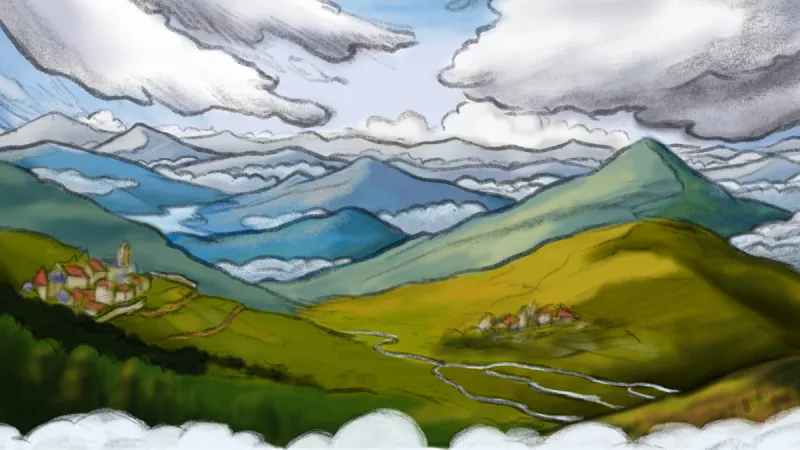
With Cuphead’s staggering success, it’s not too surprising the team at MDHR wanted to deliver one more serving of sharp shooting excitement and aggravation. Opting for DLC as opposed to a full-on sequel, the Cuphead developer set about outlining The Delicious Last Course, released in June 2022. Early in production, MDHR decided that a boss concept from the original game, one scrapped due to time constraints, would be the perfect starting point for this newest outing.
A tremendous amount of work went into designing, testing, and tweaking every boss in the original Cuphead, and The Delicious Last Course was no different. Game Informer recently sat down with Chad and Jared to get behind-the-scenes insight on the thought process behind the look and feel of a single boss – a cantankerous giant the size of a mountain.
Peak Design
Peak Design
The look and demeanor of Glumstone the Giant, or Old Man Mountain, as he was known internally, is inspired by a smattering of larger-than-life antagonists from 1930s animated shorts. While the giant’s enormous stature and many of his mannerisms come from Disney’s 1938 Mickey Mouse short The Brave Little Tailor, his flowing white beard and scraggly appearance is a direct reference to Fleischer Studios’ 1933 classic The Old Man of the Mountain, starring the flirtatious Betty Boop. In the cartoon, the titular hermit is portrayed as a feral lunatic, chasing Betty after a shared dance in his mountaintop cave.
Glumstone’s initial character design came together so early that he’s in not one but two Cuphead books published before The Delicious Last Course – The Art of Cuphead and the middle-grade novel Cuphead in A Mountain of Trouble. MDHR floated the idea of adding a never-ceasing swarm of gnomes to the Glumstone mythos early on, and it soon became the driving force behind many of his attacks and environments. Though seemingly annoyed by the gnomes, Glumstone would also work in tandem with the tiny folk, a symbiotic relationship of fairytale proportions.
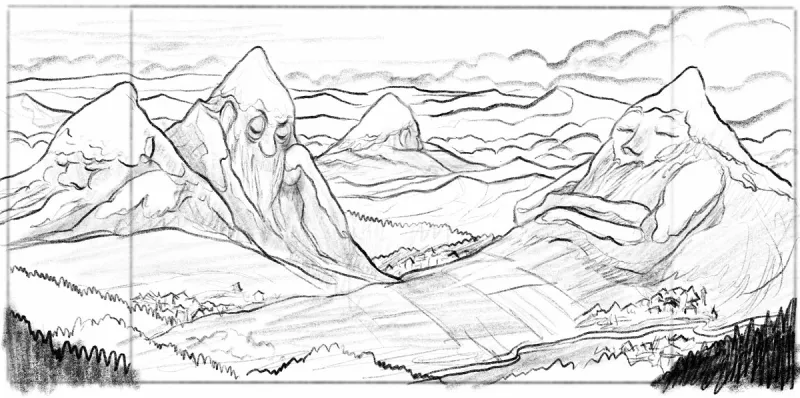
With more and more details falling into place, the Cuphead team began brainstorming the perfect setting for this new hard-hitting throwdown. The first choices included a cloudy mountain peak, a frosty winter landscape, and a treetop gnome village. “The ideas were cool, but it kept everything too close, and it didn’t feel like the giant was truly a giant,” says Chad. “So then we started going through valleys and more vast looking settings. Once we hit that, it just quickly shifted to this wide open mountainous area, and we threw in that extra lore.” The team based the lore in question around the stony faces found on each mountain, adding the implied mythology of a long-slumbering race of colossal beings.

Couldn’t Axe For More
Couldn’t Axe for More
With Glumstone’s gargantuan face taking up the right side of the screen and an army of gnomes waiting in the wings, the Moldenhauer brothers and their team set about finding just the right balance of amusement and annoyance for the boss’ first phase. They proposed, debated, and ultimately shelved many attacks, including an avalanche of gold-flavored cereal bits, gnomes skiing off slopes of unkempt hair, and a minecart rail unfurling from inside Glumstone’s gaping maw.
“There’s tons of back and forth,” Chad says about the design process. “There’s really serendipitous times where you start building off of a concept, and every idea that comes up is perfectly linked and has this ‘Aha!’ moment. But a lot of the time, it’s just a battle to get the theme to feel right without going so far away that it all feels disjointed.”
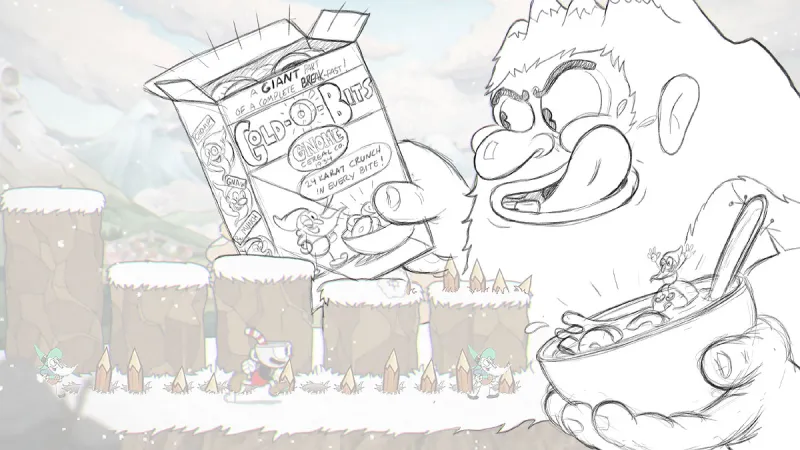
The key to Glumstone’s first phase would ultimately lie with its relentless swarm of gnomes. Though the gnomes take inspiration from classic fairy tale tropes, they’re also highly inspired by characters in the iconic arcade beat ’em up Golden Axe. Known in the original game as “thieves,” gnomes in blue drop magic pots, while those in green drop health in the form of meat and other food items.
The gnomes seen in Glumstone’s tussle would don similar colors, cooking up noxious potions in the giant’s mouth and wielding stone hammers – an homage to the Golden Axe bosses, The Bad Brothers. Other gnomes would spring forth to fire off gold nuggets, while even more were painstakingly animated directly into the stage’s beard-covered surface, only popping up to stab players who lingered too long in one spot. Glumstone’s eventual stage name, “Gnome Way Out!,” would be far from an exaggeration.
From the beginning, Chad and Jared knew they wanted an animal element in the first phase of the Glumstone fight. Only two species made the cut – geese and bears. Though MDHR conceived both as giants in their own right, they were eventually scaled down to bring more perspective to Glumstone’s size. Instead of one gnome riding a giant goose, the team decided a sudden storm of smaller geese was a better obstacle. The gnomes stayed, riding atop the majestic Canadian geese on miniature saddles, a nod to the various mountable beasts in the Golden Axe series and MDHR’s Canadian roots.
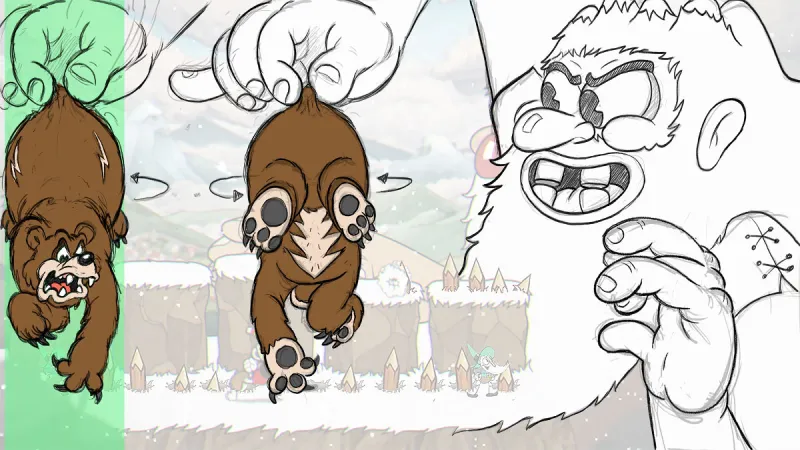
Getting a bear on screen was far more perplexing in terms of design. Initial concepts show Glumstone holding up a cave or a cage in one hand while enticing the bear with a tasty fish. One concept even had the giant making a cave out of his own hands. Though these ideas were fun and creative, MDHR ultimately deemed them too visually distracting, leading to the final animation of Glumstone simply picking up a bear by its tail and dangling it near players.
Not satisfied with a handful of Golden Axe references, Chad and Jared snuck in a few subtle references to one of their favorite SNK fighting series. The first is the patch of fur on the bear, the same pattern seen on wrestler Big Bear in Fatal Fury. “Once you discover that and you’re like, ‘Okay if the bear has an SNK reference, is there any way for the geese to have an SNK reference?’ And then we’re like, ‘There sure is!’” laughs Jared. The reference in question is on Glumstone’s “Geese X-ing” sign – a silhouette of a goose performing the signature Double Reppuken of Fatal Fury combatant Geese Howard. Both animal sight gags perfectly encapsulate the “blink and you’ll miss it” retro callbacks the Moldenhauers love leaving in plain sight.
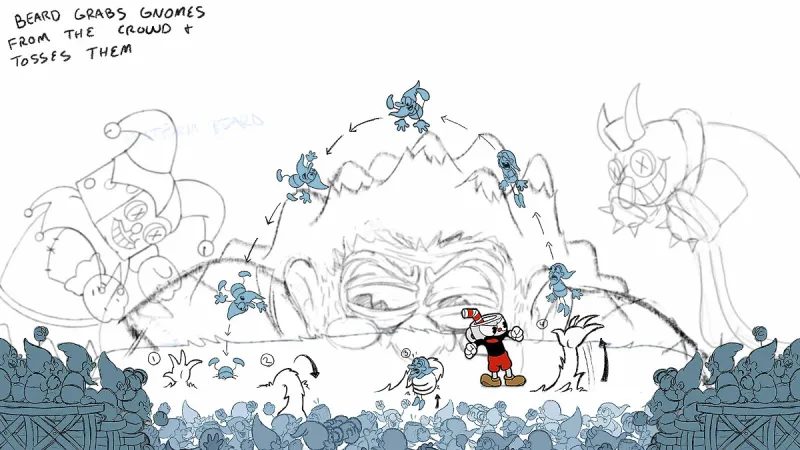
Master of Puppets
Master of Puppets
While Glumstone’s first phase is a frenzy of beasts and gnomes, one of the most hectic in Cuphead history, the second takes a much different approach. Early in development, the idea of Glumstone attacking with shadow puppets and then real puppets was heavily considered. This idea had evolved into the inclusion of real animals but was still fresh in the team’s mind when it came time to craft the next phase.
Along with puppets came a new spin on Glumstone’s relationship with his gnomes, taking inspiration from the beloved Canadian children’s show The Friendly Giant, which featured a mild-mannered giant interacting with different miniature models and puppet friends. Instead of treating the gnomes as pests, the Moldenhauers proposed that Glumstone might enjoy entertaining the little miners with a friendly puppet show of his own design. This concept bred many new questions – most importantly, how the puppets would look and attack.
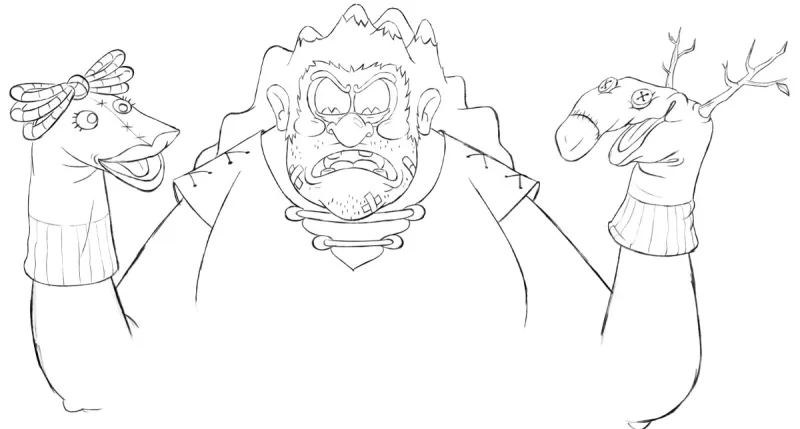
“We sketched up a few sock puppets, but there’s something that just feels 1980s about sock puppets,” says Jared. “So then we moved on to more of a felt-shaped, flappy mouth puppet, something closer to a muppet. But again, that has a weird ʼ50s to ʼ60s vibe, which is why we started focusing on puppets from older eras.”
While digging into puppets from the 1930s, the team rediscovered the work of Ladislas Starevich, a Polish-Russian stop-motion animator known for his award-winning work with puppets and dead bugs. It was within Starevich’s 1934 film The Mascot that the Moldenhauers spied a lanky devil puppet that reminded them of Cuphead’s own villain.
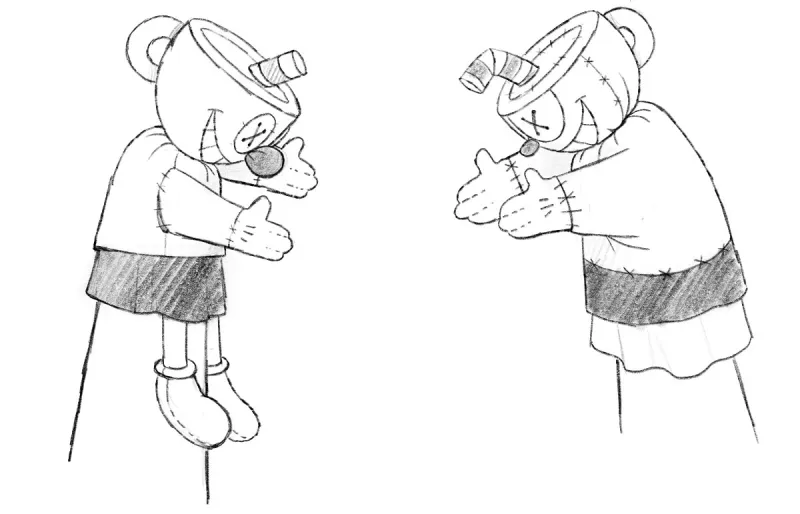
“A decision was made along the way to get it back to medieval times, where it felt like the performers could make a satire on the kings and queens of the era,” says Jared. “It was a way to kind of teach the peasants and the regular folk about valuable lessons without being jailed. So we were like, ‘Well, maybe it’s weird, but we could try to make a king version of the Devil and a jester version of King Dice, and they could reenact this thing that would tie it back to the original game.’ I think that was the key moment that felt more alive, that really pulled the DLC island into the experience of the original game.”
Though the first iteration of puppets was going to be twirling a jump rope between their stubby hands, the swinging motion created issues with projectile timing and didn’t mesh well with the new theme. The rope was soon replaced with a bouncing sack of coins; one hoisted back and forth by the corrupt figureheads of Inkwell Isles. Once paired with the beard-bouncing antics of gnomes, the second phase found an enjoyable balance of theme and challenge.
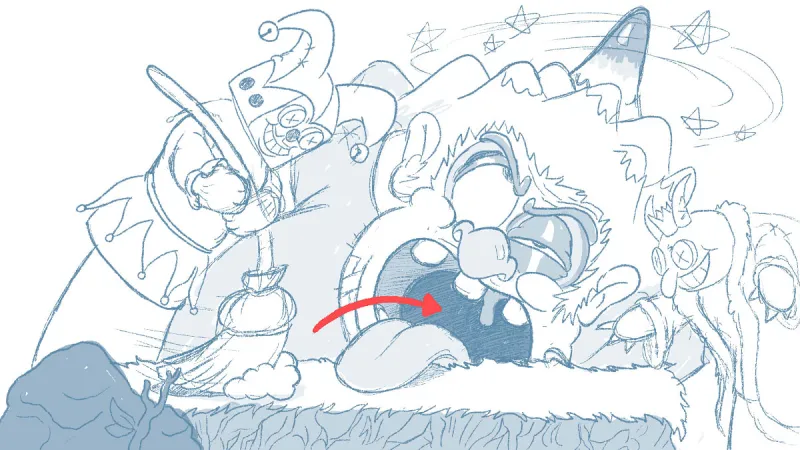
Gut Check
Gut Check
Anyone who has played Cuphead knows the subconscious panic of encountering a boss’ final phase. For this reason, Studio MDHR tries to push for final phases that are neither the longest nor the most difficult compared to those that came before. Not that the last stage of every battle is easy to overcome or adapt to, but the team does its best to ensure the environment isn’t too overbearing as players’ hit points wane and they inch closer to success.
Much like the concepts of gnomes, animals, and puppets, the theme for phase three came to the Cuphead team early on – players were going to be eaten alive. Inspired by the long-standing video game trope of fighting a supersized enemy from inside their very guts – perhaps most notably in Yoshi’s Island for the Super Nintendo – Glumstone’s last resort would be an act of desperation. Chad and Jared’s first thought was to have players go up against a master gnome, one lying in wait inside the giant, but thematically it didn’t make much sense. Players needed to be attacking Glumstone, not some enemy taking refuge in his stomach. Thus a bulging stomach ulcer with a mind of its own would take the stage, spitting bones and chicken legs, a final nod to Golden Axe.
Unlike the first two phases, where players could rely on stable (albeit gnome-infested) footing, from the start, MDHR planned Glumstone’s stomach as a pit, one that would eventually be filled with glowing green acid à la 1993’s Mortal Kombat II. “It was an old idea that we just never pursued, but we really liked the video game moments that eliminate the platforms from you,” Jared recalls. “You have to learn to dodge and aim while reducing your play space. We had that pattern down first before we had any concrete idea or layout of what exactly this stomach would look like.”
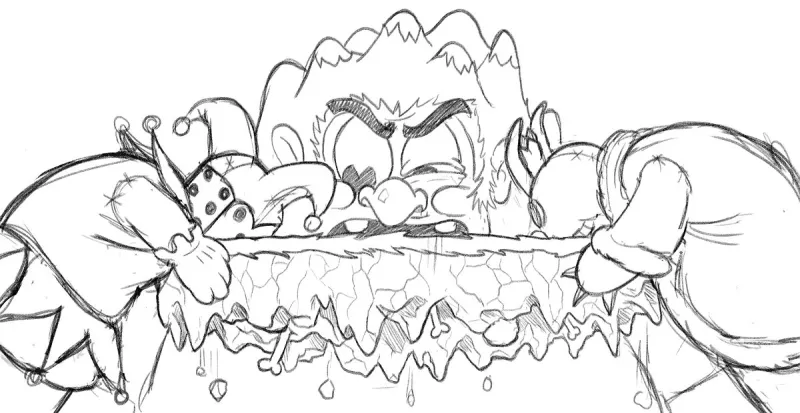
While it made sense that players might be hopping between bits of digested food, it turned out to be a somewhat underwhelming visual. Instead of focusing on what the giant had eaten, the Moldenhauers brainstormed what might live inside his mighty belly. “We looked at some of these nightmarish early Fleischer cartoons, like Swing You Sinners,” Chad says. “It’s almost like our go-to when we want something creepy and monster-esque.”
“But it’s always important to maintain the cuteness of the nightmare,” adds Jared. “It’s kind of gross to have ulcers and an acid pit, but then it’s completely flipped on its head as soon as you see the ulcer is feeding these cute little animals inside of his stomach.”
And so, five sawtoothed monsters, a mix of creepy and cute, were added as the platforms for phase three, their skeletal appearance another subtle nod to Mortal Kombat II’s flesh-melting acid pit. Swimming alongside them would be gnomes in full diving gear with blow guns, a direct reference to the scuba ninjas found in the original Shinobi.
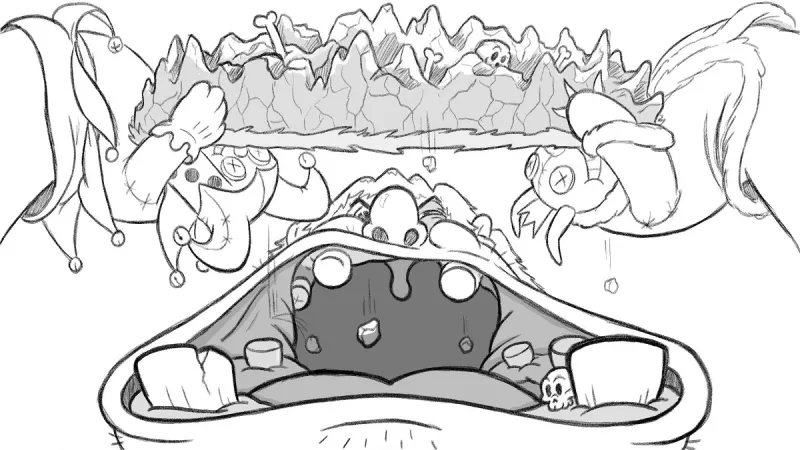
The last aspect of phase three, which would tie everything together, was a living, breathing backdrop. With the ulcer wriggling across the top of the scene, the team wanted a background that could shift and pulsate with it, a task easier said than done. To get the right feel, artist Caitlin Russell spent over 300 hours hand-painting multiple layers and each individual frame of the ulcer’s grotesque movement.
“It’s one of those things where you can’t quite tell how much work went into it, but if you really look and analyze it, you’re like, ‘Okay, this is a little bit crazier than maybe some people know,’” says Chad.
“It’s all a painting. It’s so much extra work to just get something that doesn’t throw you off,” Jared adds. “It’s only noticeable if you do a bad job and it becomes jarring. Whereas when you’re playing it, you’re just like, ‘Oh, that’s a nice background with the ulcer.’ But it took a ton of work to fill that experiment.”
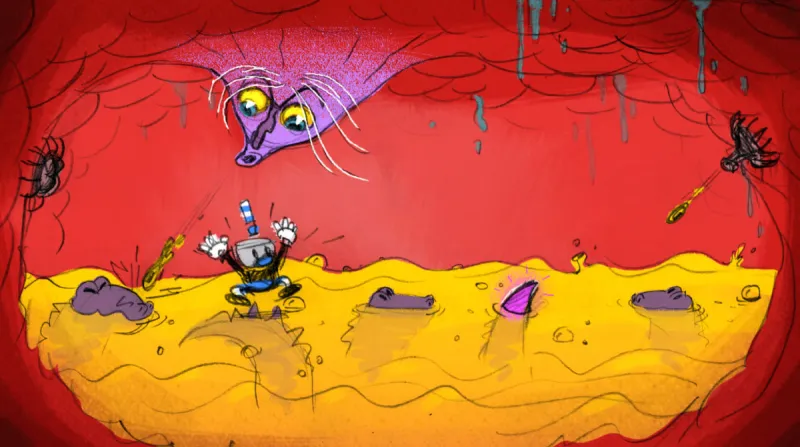
What A View
What a View
And thus, with the ulcer defeated, Glumstone the Giant’s battle came to an end. Though the entire boss fight can be finished in under two minutes, the designs, attacks, and thematic storytelling took years to perfect. Coupled with beautiful backdrops and a swinging score by composer Kris Maddigan, the stage was ready to challenge any player brave enough to face the gargantuan boss. The magic of Cuphead comes not just with overcoming seemingly insurmountable odds but also the small surge of joy one feels when discovering a reference hidden in the chaotic hail of projectiles and platforms. The Moldenhauer brothers and their team at Studio MDHR wouldn’t want it any other way.
This article originally appeared in Issue 349 of Game Informer.
